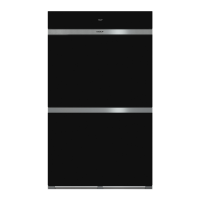M Series Wall Oven
M Series Wall Oven
Troubleshooting
4-22
#824974 - Revision C - November, 2016
Procedure I: TCO Open
Environmental issues are the major reason for the TCO getting excessively hot and opening. Environment issues
should be eliminated first, then proceed to unit issues.
Environmental Issues:
1. Ambient temperature near oven is too high. Room temperature near the oven must be below 86° F. Verify
heating ducts are not oriented toward the oven.
2. Verify width, height, and depth match Installation Guide specifications to ensure cabinet is not too tight.
3. Single oven side by side installation only, verify "Dual Installation" sales accessory is installed correctly.
4. Confirm ground by measuring resistance from unit cabinet to adjacent ground terminal for continuity.
5. Confirm 115 VAC from L1 and L2 to Ground. Confirm 230 VAC L1 to L2.
6. Oven did not cool completely between back to back self-clean cycles. Allow oven to cool completely after
self-clean prior to initiating a self-clean in a second oven in a double oven, in an adjacent oven, or the same
oven.
Unit Issues:
1. Cooling fan is not operating at the correct speed. Remove connector and measure resistance J5-6 to J5-8
(upper and single oven) and J6-7 to J5-8 (Lower oven). If not 45 ohms ±20% replace cooling fan.
2. Door gasket is not sealing consistently around the door. Reposition or replace gasket. Ensure gasket bead is
fully seated and the gasket perimeter bulb is not stuck under the collar.
3. Lower trim out of alignment. Ensure a 1/4” gap between the bottom of the door and top of the lower trim.
4. TCO or TCO circuit is open. Measure resistance P2-4 to L2 (single and upper oven) or P6-4 to L2 (Lower
oven). If no continuity inspect terminal block, L2 wiring, and TCO(s). If no damage replace the TCO.
5. Bake pan not seated properly. Push bake pan all the way back in the oven. Ensure a proper insulation seal
behind the bake pan. Ensure bake pan spacers are flush against bake pan and the cabinet they are
attached to.
6. Cooling fan out of position. Loosen the four screws holding the cooling fan exhaust duct and ensure the
cooling fan is seated into the lowest position possible.
7. Insulation gaps around convection fans. Ensure back insulation piece is beneath the side insulation piece,
and no voids are being formed.
8. Wires in TCO air flow path. Ensure all wires in front of TCO are secured in wire clips.
NOTE: Single ovens have an upper and lower TCO in series. If TCO circuit is open on a single oven both TCOs
must be checked.

